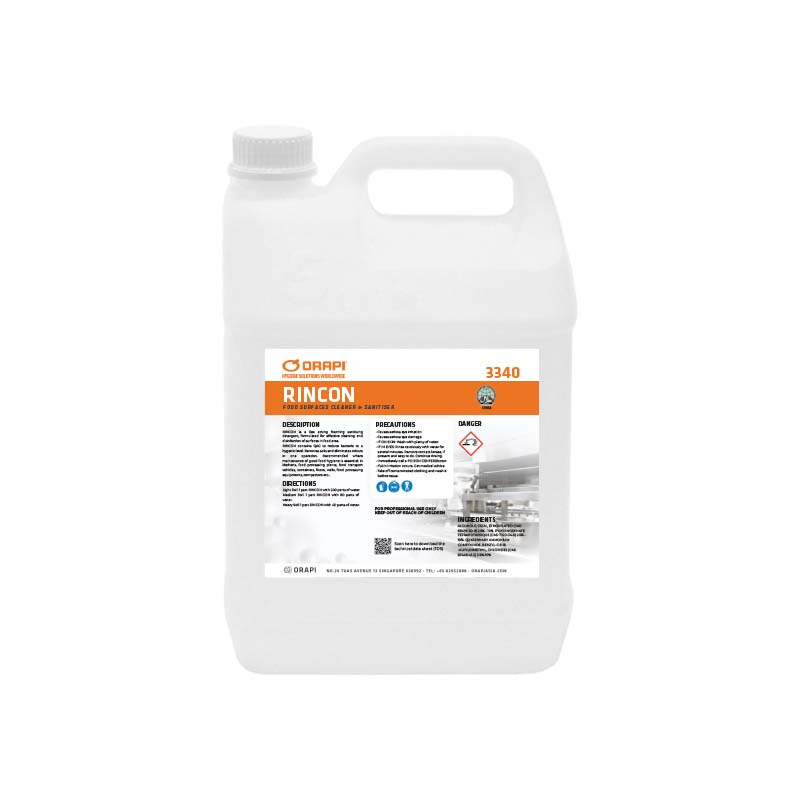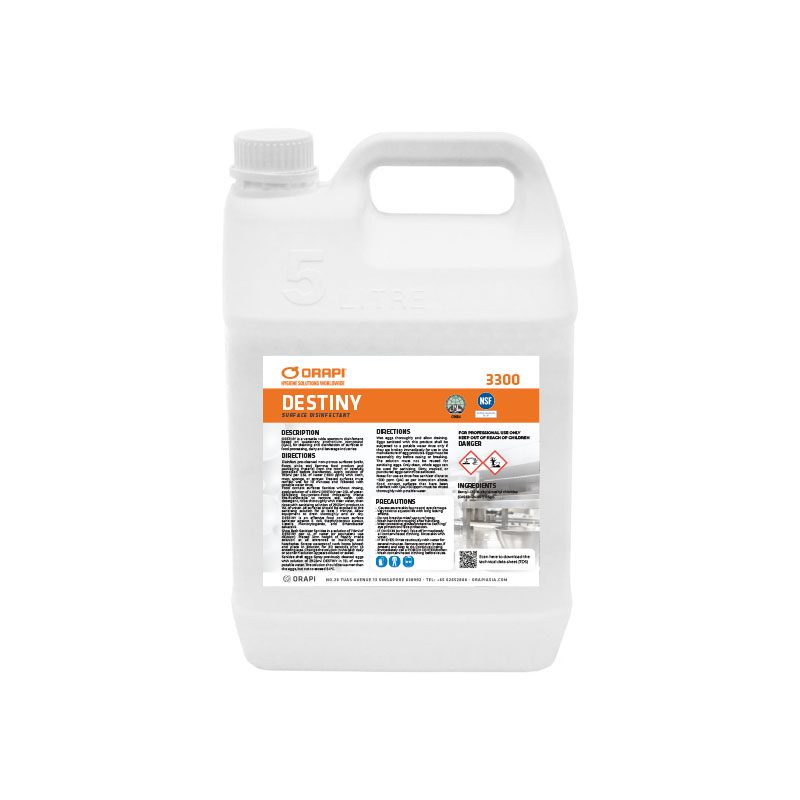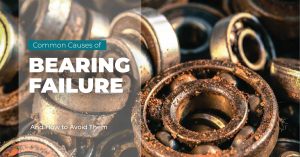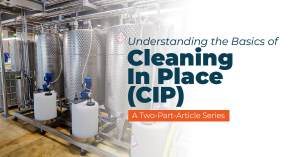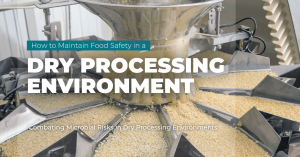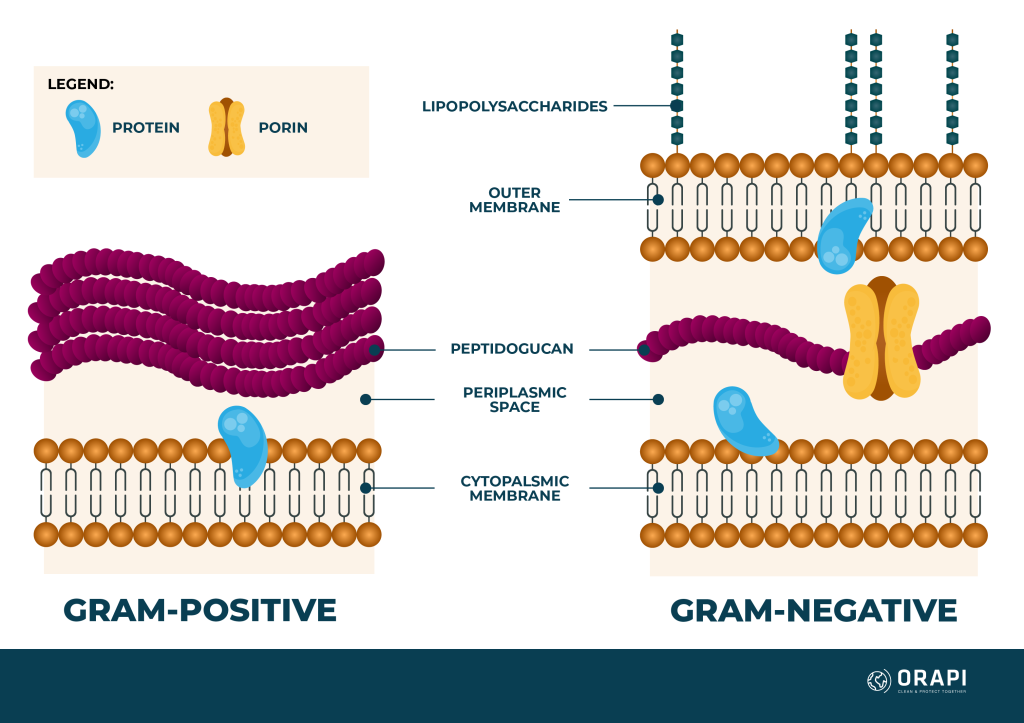
What is the difference between gram-positive and gram-negative in bacteria?
GRAM-NEGATIVE
Gram-negative bacteria are a type of bacteria with a unique cell wall structure that distinguishes them from Gram-positive bacteria. Their cell wall comprises a thin layer of peptidoglycan, surrounded by an outer membrane (OM) made up of lipopolysaccharides and phospholipids and a cytoplasmic inner membrane (IM).
Outer Membrane
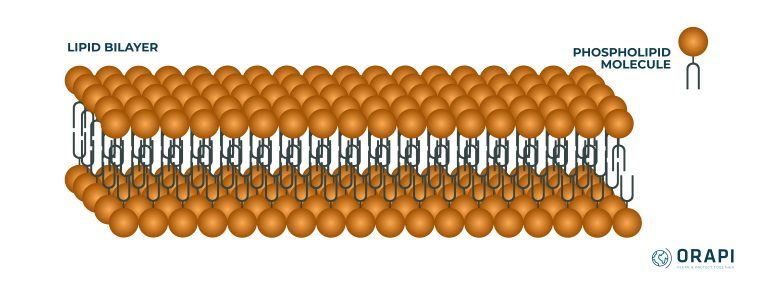
Peptidoglycan
Bacteria have a rigid exoskeleton, and this is due to the presence of peptidoglycan in their cell walls. Peptidoglycan comprises repeating units of N-acetyl glucosamine-N-acetyl muramic acid and is cross-linked by pentapeptide side chains. The peptidoglycan sacculus, which is the entire structure of the peptidoglycan, is a large polymer that can be viewed under a light microscope. The rigidity of peptidoglycan is essential in determining the shape of bacterial cells, and this also explains why they do not lyse or burst when put into distilled water.

Therefore, we can say that the peptidoglycan serves some essential functions, including:
- Provides structural support: The peptidoglycan cell wall gives the bacterial cell its shape and rigidity and helps it withstand changes in osmotic pressure.
- Protects against osmotic lysis: The peptidoglycan cell wall creates a semi-permeable barrier that prevents the influx of water and other solutes, which could cause the cell to burst.
- Contributes to pathogenicity: In some bacterial species, the peptidoglycan cell wall may contain virulence factors that allow the bacteria to evade the host immune system or adhere to host tissues.
- The target for antibiotics: The peptidoglycan cell wall is a target for many antibiotics, including penicillin, which inhibits its synthesis and weakens the bacterial cell wall, leading to cell death.
What is Lysing?
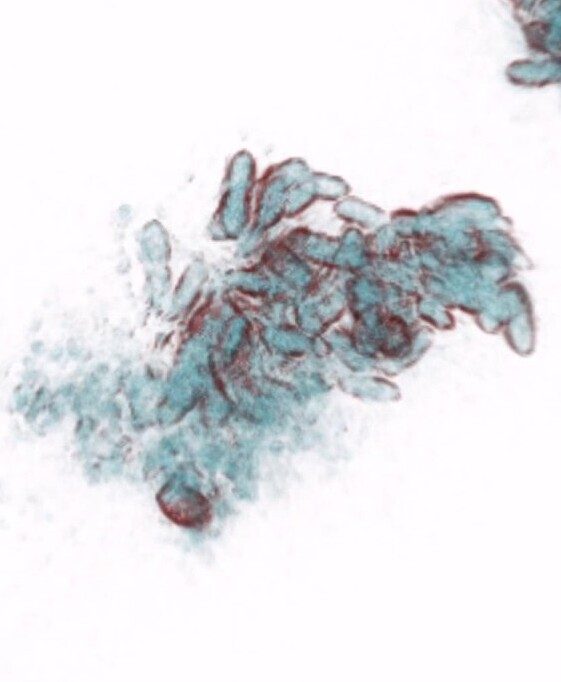
In biology, the term “lyse” refers to the destruction or breakdown of a cell membrane, resulting in the release of its contents. When a cell undergoes lysis, it can be caused by various factors such as exposure to extreme temperatures, osmotic shock, mechanical damage, or exposure to lytic enzymes produced by other cells or organisms. Lysis is a natural process that occurs during the normal life cycle of some cells, but it can also be a harmful or lethal event for others, such as bacterial cells being destroyed by certain antibiotics or the lysis of red blood cells during a hemolytic reaction.
The Periplasm
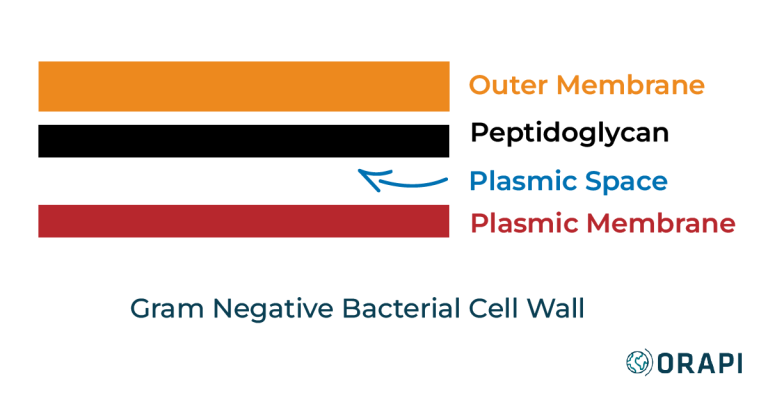
The outer membrane (OM) and inner membrane (IM) of Gram-negative bacteria create a space between them called the periplasm. This compartment is filled with proteins and is thicker and more viscous than the inside of the cell. The periplasm helps the bacteria keep harmful enzymes separate from the rest of the cell, like how lysosomes work in human cells. Proteins in the periplasm include those that help transport sugars and amino acids, as well as molecules that help build the cell envelope.
Inner Membrane
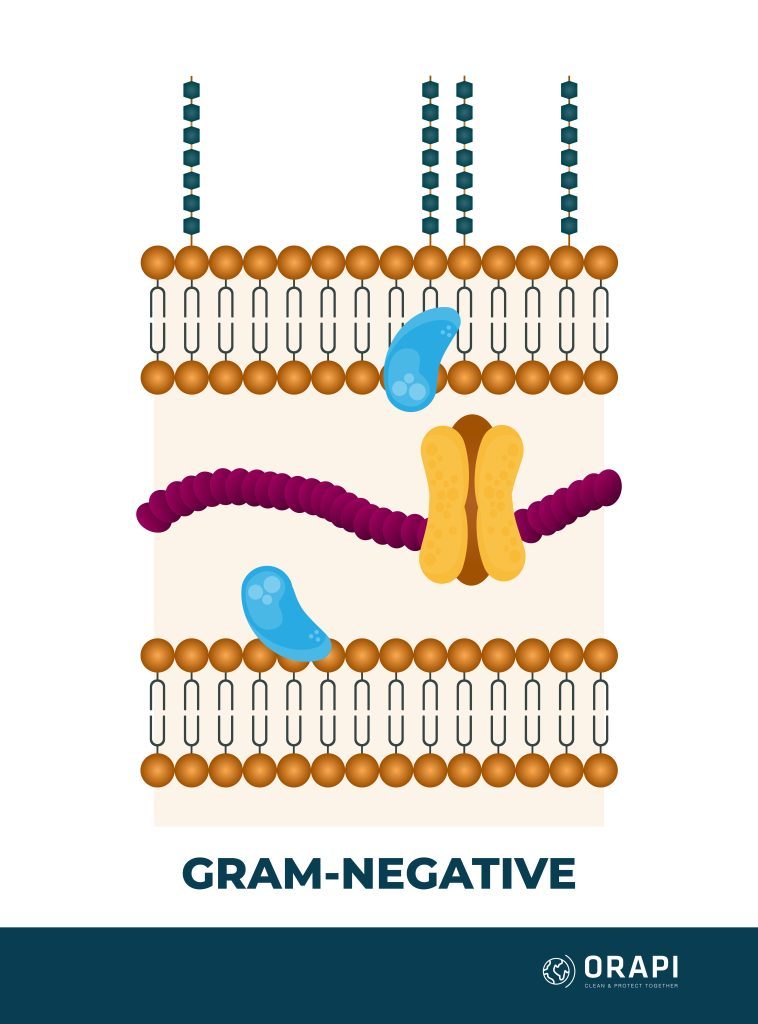
Gram-negative bacteria do not have intracellular organelles like more complex organisms do, so all of the functions of these organelles related to membranes are performed by the IM in bacteria. Many of the membrane proteins in bacteria that are involved in producing energy, making lipids, secreting proteins, and transporting molecules are similar to those found in more complex organisms, but their location in the cell is different. In bacteria, these proteins are located in the IM. Finally, the IM is made up of a phospholipid bilayer, which is a double layer of lipids that separates the bacterial cell’s cytoplasm from the external environment.
Staining Properties
When subjected to the Gram staining process, Gram-negative bacteria appear red or pink under the microscope due to their thinner peptidoglycan layer, which does not retain the crystal violet stain used in the process. Some examples of Gram-negative bacteria include Escherichia coli, Salmonella, Pseudomonas aeruginosa, and Neisseria gonorrhoeae.
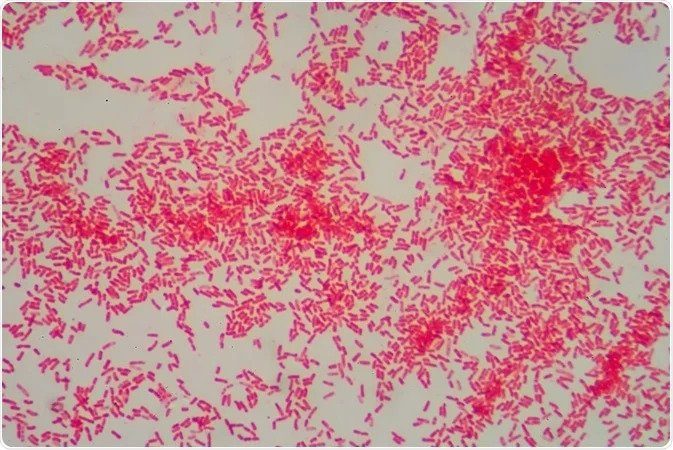
Resistance to Antibiotics
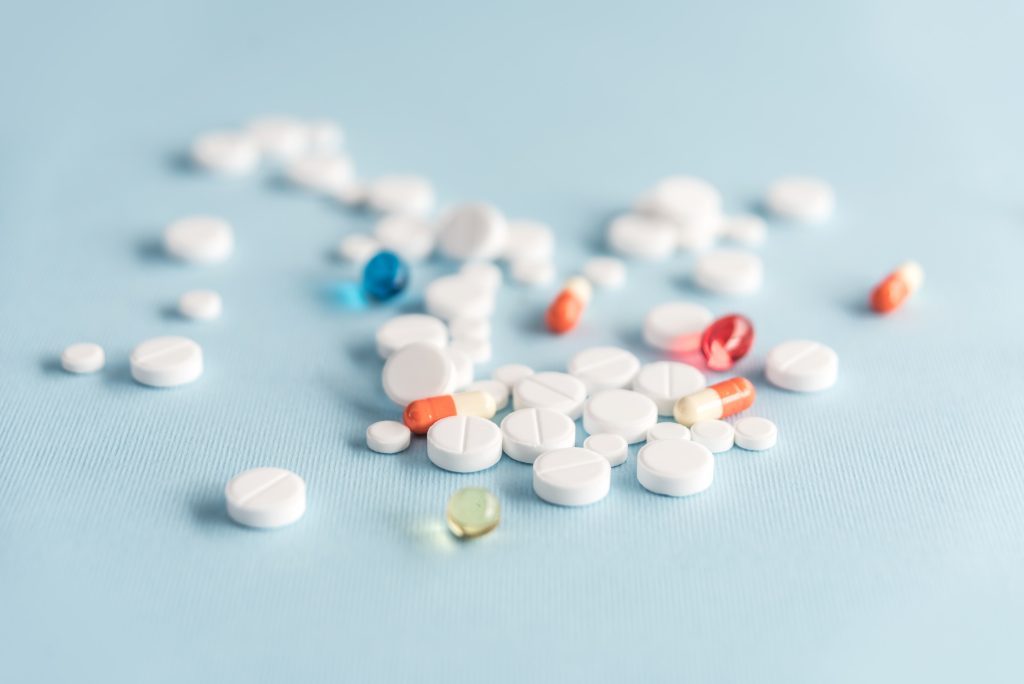
Gram-negative bacteria can be found in a wide range of environments, including soil, water, and the human body. Some Gram-negative bacteria are beneficial to humans, while others are pathogenic and can cause a variety of infections and diseases.
As we mentioned before, all antibiotics target peptidoglycan cell walls. However, gram-negative bacteria have higher antibiotic resistance due to the complex wall structure. This outer membrane, composed of lipopolysaccharides and proteins, forms a protective barrier that restricts the entry of many antibiotics into the bacterial cell and helps stabilise the inner membrane. Additionally, gram-negative bacteria possess efflux pumps that can actively pump out antibiotics that have entered the cell, further reducing the effectiveness of antibiotics. This combination of an outer membrane barrier and efflux pumps makes gram-negative bacteria more resistant to antibiotics than gram-positive bacteria.
Gram Negative Bacteria In Food Processing
Several types of Gram-negative bacteria can be found in food processing plants, including:
- Escherichia coli (E. coli): is a Gram-negative, rod-shaped bacterium that commonly inhabits the intestinal tract of humans and animals. It is a common cause of foodborne illness when ingested through contaminated food or water.
- Salmonella: is a Gram-negative, rod-shaped bacterium that can cause food poisoning and is often found in raw poultry, eggs, and meat products.
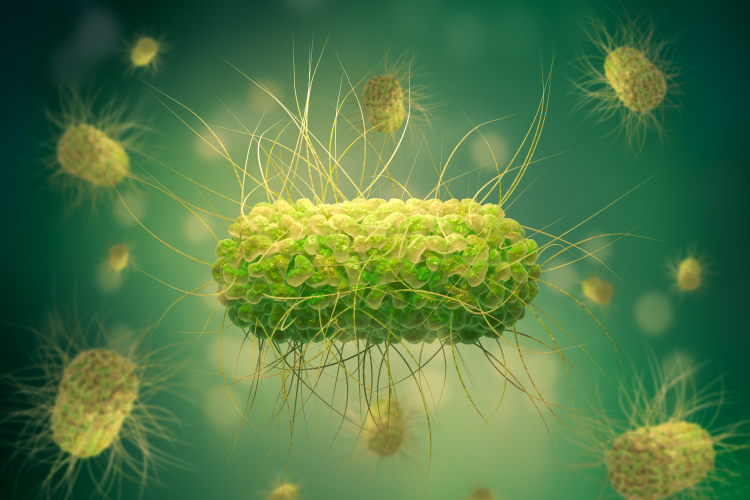
3. Campylobacter: is a Gram-negative, spiral-shaped bacterium that can cause gastrointestinal illness and is often found in raw poultry and meat products.
4. Vibrio: is a Gram-negative, curved-shaped bacterium that can cause illness from consuming raw or undercooked seafood, such as oysters or shellfish.
5. Pseudomonas: is a Gram-negative, rod-shaped bacterium often found in moist environments and can cause infection in people with weakened immune systems. It can be found in food processing plants, equipment, and other settings.
These bacteria can also be found in other environments, not just food processing plants. Proper sanitation and hygiene practices are vital in preventing contamination and the spread of these bacteria.
Toxins Produced
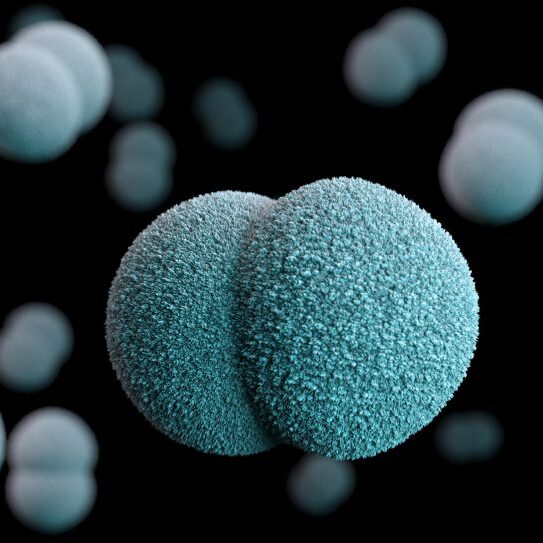
Gram-negative bacteria produce diverse toxins that can cause different types of infections and diseases. Some examples of the toxins produced by Gram-negative bacteria include:
- Endotoxins: are the liposaccharide pyrogenic substances (induce fever) found in the cell wall of these bacteria and are released when the bacteria die or are destroyed. Endotoxins can cause fever, sepsis, shock, and other serious conditions.
2. Exotoxins are proteins produced by Gram-negative bacteria and secreted into the surrounding environment. Exotoxins can cause a range of symptoms depending on the type of toxin and the affected tissues or organs. Some examples of exotoxins produced by Gram-negative bacteria include:
-
- Shiga toxins: are produced by certain strains of Escherichia coli (E. coli) and can cause bloody diarrhoea, kidney failure, and other complications.
- Cholera toxin: is produced by Vibrio cholerae and can cause severe diarrhoea, dehydration, and electrolyte imbalance.
- Pertussis toxin: produced by Bordetella pertussis and can cause whooping cough, a respiratory infection that can be life-threatening, especially in infants and young children.
- Tetanus toxin: produced by Clostridium tetani and can cause muscle spasms and other symptoms associated with tetanus, a serious infection that affects the nervous system.
3. Lipopolysaccharides (LPS) are also part of the cell wall of Gram-negative bacteria and can stimulate the immune system to produce inflammation and other responses. LPS can contribute to sepsis and other conditions associated with Gram-negative bacterial infections.
Overall, the toxins produced by Gram-negative bacteria can cause many symptoms and complications, and treatment typically involves antibiotics and supportive care for any related symptoms or complications.
ORAPI RECOMMENDS:
Food Surfaces Cleaner and Sanitizer
RINCON is a foaming sanitizing detergent formulated for effectively cleaning and disinfecting surfaces in food areas. RINCON is formulated with a blend of detergents, sequestrants and quaternary ammonium compounds specially selected to be effective against a wide range of microorganisms for maximum hygiene.
GRAM-POSITIVE
Gram-positive bacteria are a type of bacteria that have a thick cell wall consisting of a layer of peptidoglycan. This thick cell wall makes them appear purple when stained with the Gram stain.
Structure
Gram-positive bacteria do not have an outer membrane like Gram-negative bacteria, and an additional phospholipid bilayer does not surround their cell wall. This gives them a simpler structure than Gram-negative bacteria. Without the outer membrane (OM), Gram-positive bacteria have thicker peptidoglycan layers to withstand the turgor pressure exerted on the plasma membrane. These layers of peptidoglycan contain long polymers called teichoic acids, which make up over 60% of the Gram-positive cell wall mass. Wall teichoic acids are covalently attached to peptidoglycan, while lipoteichoic acids are anchored to membrane lipids. These polymers contribute significantly to the structure and function of the cell envelope. Gram-positive bacteria also have various proteins that decorate their surfaces, and unlike Gram-negative bacteria, these proteins do not have an outer membrane to contain them. Therefore, these proteins have elements that retain them in or near the membrane.
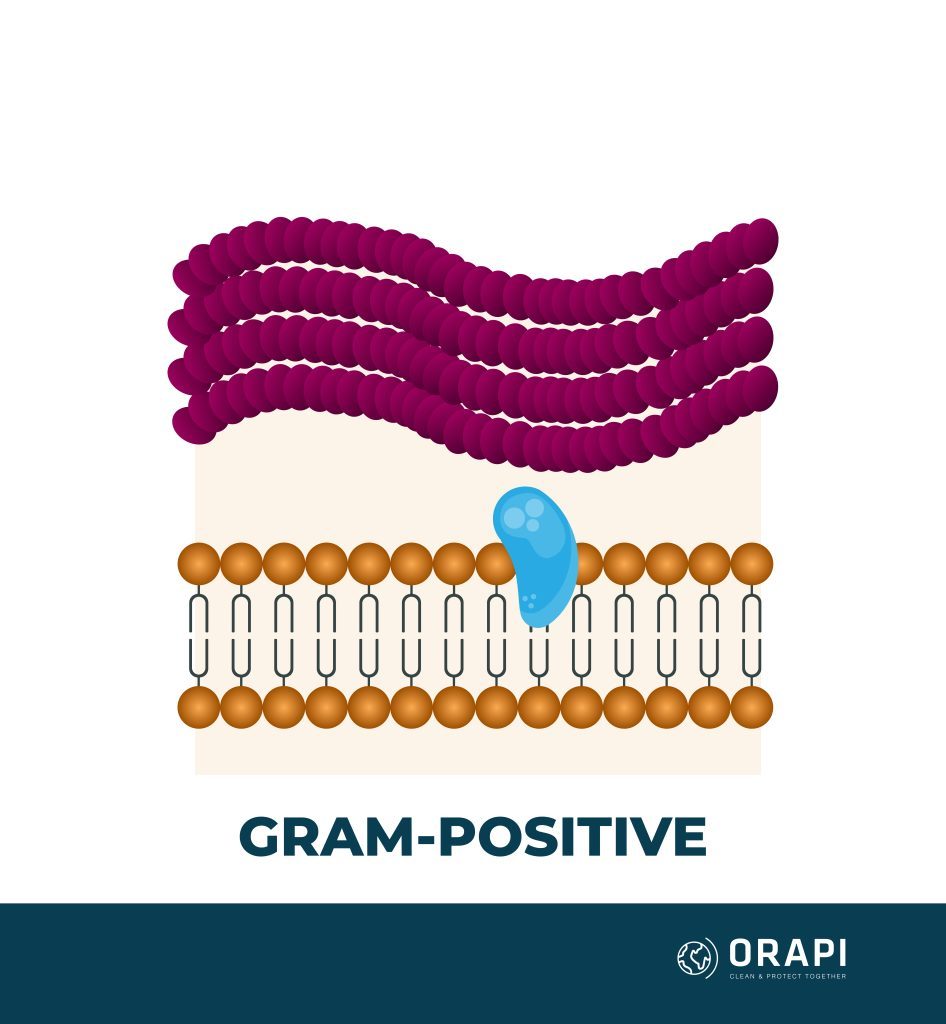
Gram-positive bacteria can have various shapes, including spherical (cocci) or rod-shaped (bacilli) forms. They are found in a wide range of environments, including soil, water, and the human body, and some species can cause infections in humans and animals. In addition, many Gram-positive bacteria are important for human health, such as those used in the production of antibiotics or those that live in the gut and help with digestion.
Turgor Pressure
Turgor pressure is the pressure that develops within a cell due to water entering the cell by osmosis. When a plant or bacterial cell is placed in a hypotonic solution (i.e., a solution with a lower concentration of solutes than the cell’s cytoplasm), water moves into the cell, and the cell membrane pushes against the cell wall, generating turgor pressure. Turgor pressure is vital for maintaining the shape and rigidity of cells.
In bacteria, turgor pressure can influence cell growth and division, as well as the ability to resist osmotic stress. If a gram-positive bacterial cell loses turgor pressure, it can become flaccid and unable to maintain its shape, potentially leading to cell death.
Peptidoglycan
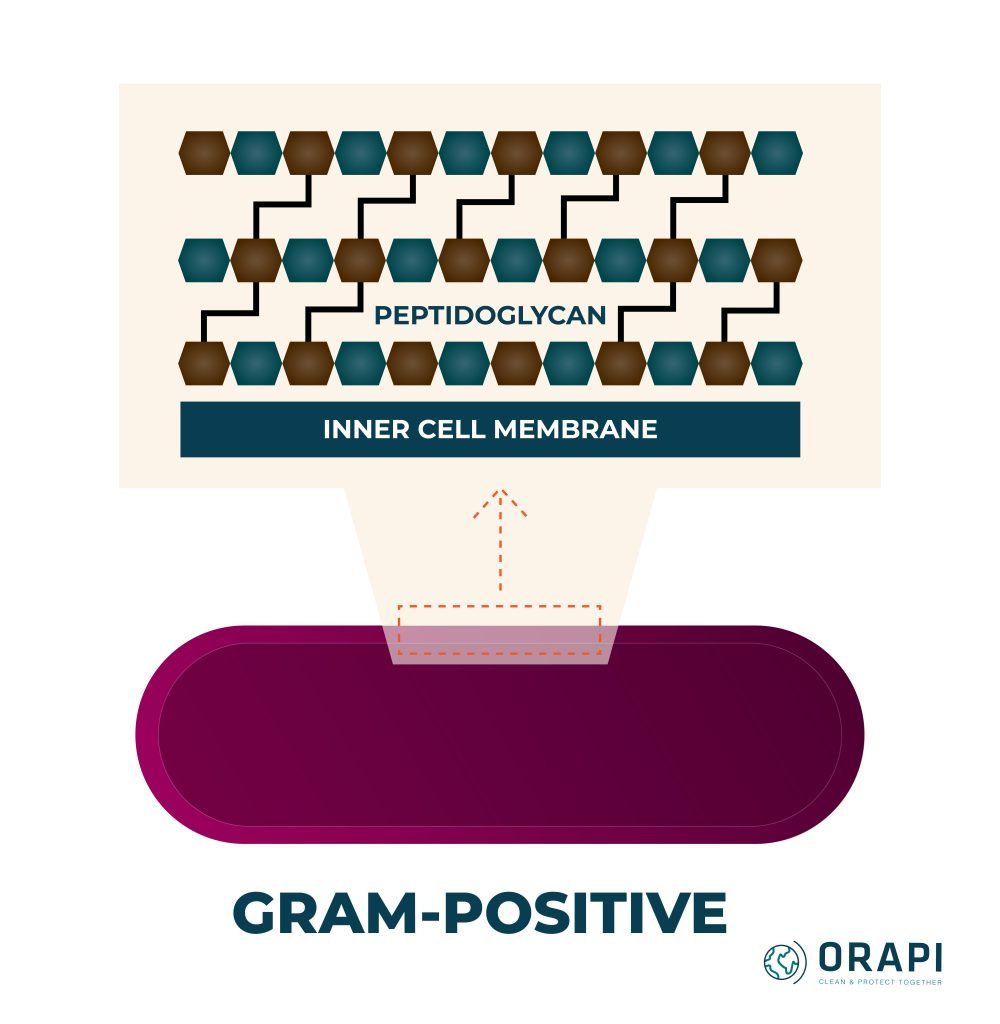
Gram-positive peptidoglycan is significantly thicker than Gram-negative peptidoglycan, consisting of many layers up to 100 nm thick. In contrast, Gram-negative peptidoglycan is only a few nanometers thick, typically composed of one to a few layers surrounding the plasma membrane.
Teichoic Acids
Teichoic acids are long, anionic polymers composed of glycerol phosphate, glucosyl phosphate, or ribitol phosphate repeats found in many Gram-positive bacteria’s cell walls. These polymers thread through the layers of peptidoglycan in the cell wall, and they can account for over 60% of the mass of the Gram-positive cell wall. There are two classes of teichoic acids: teichoic wall acids, which are covalently attached to peptidoglycan, and lipoteichoic acids, which are anchored to the head groups of membrane lipids.
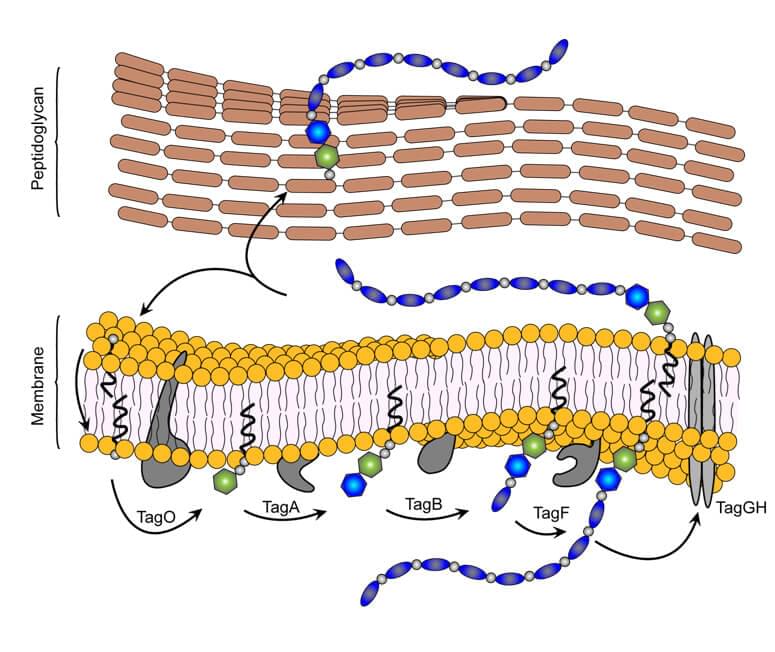
Teichoic acids are important contributors to the structure and function of the cell envelope in Gram-positive bacteria, and they have been implicated in a variety of processes, including cell division, cell wall synthesis, and host-pathogen interactions.
Staining Properties
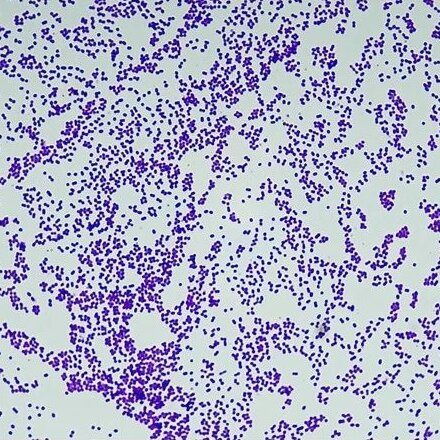
Gram-positive bacteria appear purple or blue after Gram staining. This is because their thick peptidoglycan layer traps the crystal violet-iodine complex applied during the staining process, preventing it from being washed out with alcohol or acetone. As a result, the bacteria retain the purple dye when counterstained with safranin. The thick peptidoglycan layer is also responsible for the structural integrity of the cell wall and protects the bacteria from physical and osmotic stress.
Gram-Positive Bacteria In Food Processing
There are many types of Gram-positive bacteria in the food processing industry. Some examples include:
- Listeria monocytogenes: Gram-positive facultatively anaerobic rod-shaped bacterial species. It is commonly found in soil, water, and some animals. It can cause listeriosis, a serious infection that can be fatal to some people.
- Staphylococcus aureus: Gram-positive cocci (round-shaped) bacteria that can cause a range of infections, from minor skin infections to more serious conditions like pneumonia and sepsis.
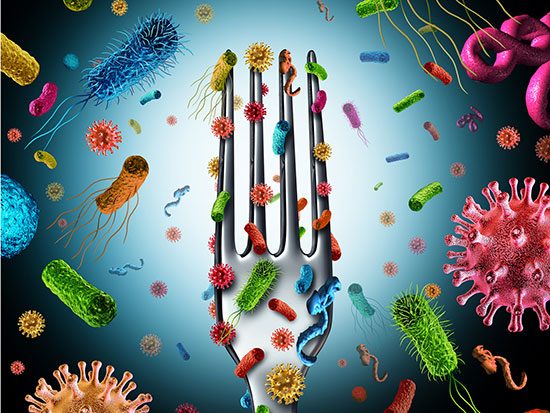
3. Bacillus cereus: Gram-positive, spore-forming bacteria that can produce toxins causing foodborne illness. It is commonly found in soil and some foods.
4. Clostridium botulinum: Gram-positive, spore-forming bacteria that can produce a potent neurotoxin that causes botulism, a severe and potentially deadly illness. It is commonly found in soil and aquatic sediments.
5. Streptococcus thermophilus: Gram-positive cocci bacteria commonly used in the production of yoghurt and other fermented dairy products. It is a lactic acid bacteria that help to ferment the lactose in milk to produce lactic acid.
Toxins Produced
Gram-positive bacteria release several toxins that can cause various diseases and infections. However, some of the prominent ones include:
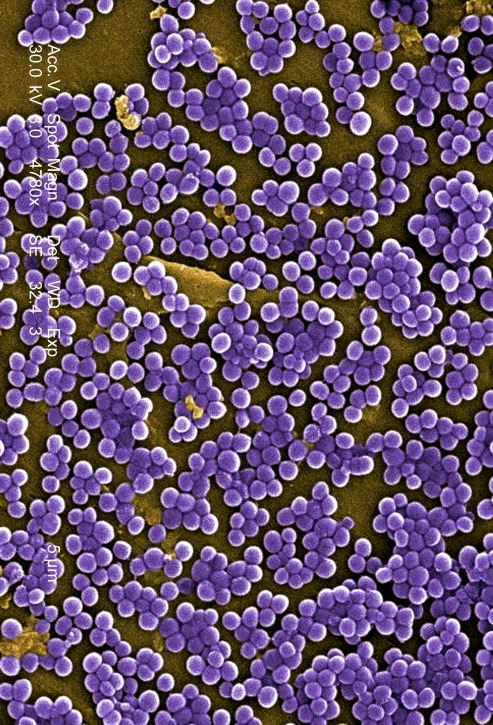
- Emetic toxin: This toxin is produced by certain strains of Bacillus cereus, a Gram-positive bacteria commonly found in soil and dust. The emetic toxin causes vomiting and nausea when consumed in contaminated food. The toxin is heat-stable and can survive even after the contaminated food is cooked.
- Diarrheal enterotoxins: These are toxins produced by some strains of Staphylococcus aureus and Bacillus cereus. They cause diarrhoea and other gastrointestinal symptoms when consumed in contaminated food. The toxins are heat-stable and can survive even after the contaminated food is cooked.
3. Neurotoxins: These are toxins produced by some strains of Clostridium botulinum, a Gram-positive bacteria commonly found in soil. The neurotoxins cause botulism, a rare but serious illness that can cause paralysis and even death. Botulism is usually caused by consuming contaminated food, particularly home-canned or preserved foods.
4. Enterotoxin: This is a toxin produced by some strains of Clostridium perfringens, a Gram-positive bacteria commonly found in soil and the intestines of humans and animals. The enterotoxin causes diarrhoea and other gastrointestinal symptoms when consumed in contaminated food. The toxin is heat-resistant and can survive even after the contaminated food is cooked.
Proper food handling and sanitation practices can help prevent the spread of these bacteria and their toxins.
ORAPI RECOMMENDS:
DESTINY 3300 is a Versatile wide-spectrum disinfectant based on quaternary ammonium compound (QAC), for cleaning and disinfection of surfaces in food processing, dairy and beverage industries.
It provides superior protection against a wide range of microorganisms including gram-positive and gram-negative bacteria, yeasts, moulds, fungi, and algae. In fact, if a disinfectant without rinsing is desired, a solution of 4.88ml of DESTINY per 2.5L of water, with approximately 200 ppm QAC, can be used.
Controlling Bacterial Growth in Food Processing Units
Controlling the growth and spread of gram-positive and gram-negative bacteria is critical in food processing units to ensure the safety and quality of food products. Here are some ways to control the bacteria:
- Sanitation and hygiene practices: Proper sanitation and hygiene practices should be implemented to prevent contamination of food products. This includes regularly cleaning and sanitising equipment, surfaces, and hands and ensuring employees follow good hygiene practices.
- Temperature control: Bacteria thrive in warm temperatures, so controlling the temperature of food products during processing and storage is important to prevent the growth of bacteria. Food should be stored at appropriate temperatures and cooked to the proper temperature to kill any bacteria present.
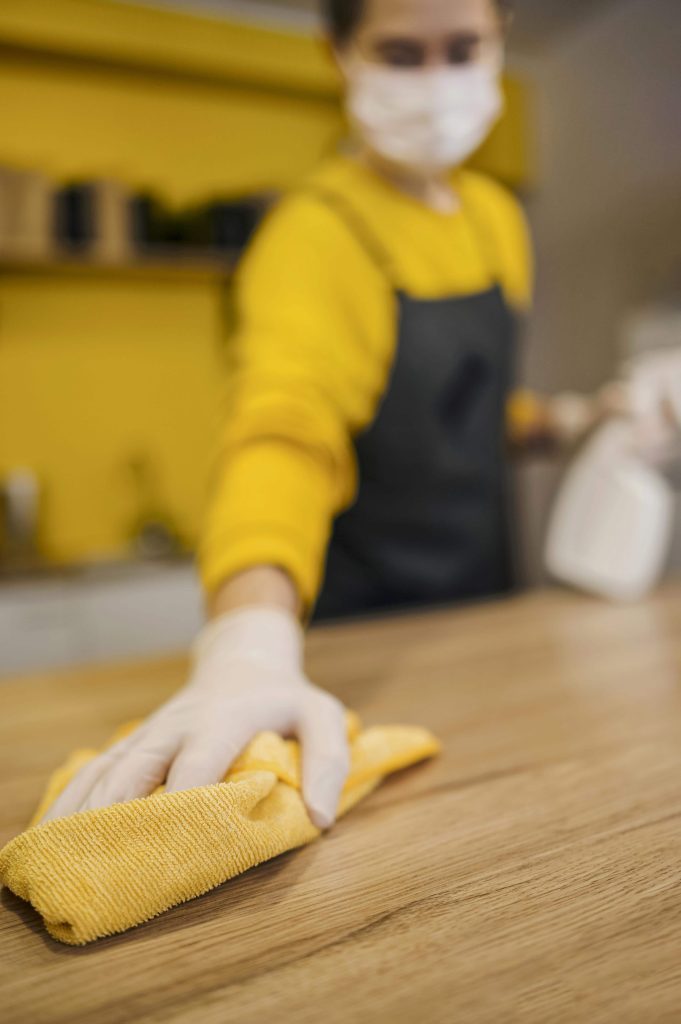
3. pH control: Some bacteria thrive in acidic environments, while others prefer alkaline environments. Controlling the pH of food products can help prevent the growth of bacteria.
4. Antibacterial treatments: Antibacterial treatments can be used on equipment and surfaces to kill bacteria and prevent their spread.
5. Use of preservatives: Certain preservatives can be added to food products to prevent the growth of bacteria.
6. Hazard Analysis and Critical Control Points (HACCP) plan: A HACCP plan is a preventative approach to food safety that identifies potential hazards and implements controls to prevent them.
Conclusion: Gram Positive and Gram Negative
In conclusion, understanding the differences between gram-negative and gram-positive bacteria is crucial for maintaining food safety in the food processing industry. Gram-negative bacteria have an outer membrane, are more resistant to antibiotics, and produce endotoxins and exotoxins that can cause foodborne illness. Meanwhile, gram-positive bacteria have a thick layer of peptidoglycan and teichoic acid, produce enterotoxins and neurotoxins, and are susceptible to some antibiotics. Effective control measures, such as proper sanitation, hygiene, temperature control, and the use of food preservatives and antimicrobial agents, can help prevent the growth of both types of bacteria and ensure high standards of quality and safety in the food supply chain.


